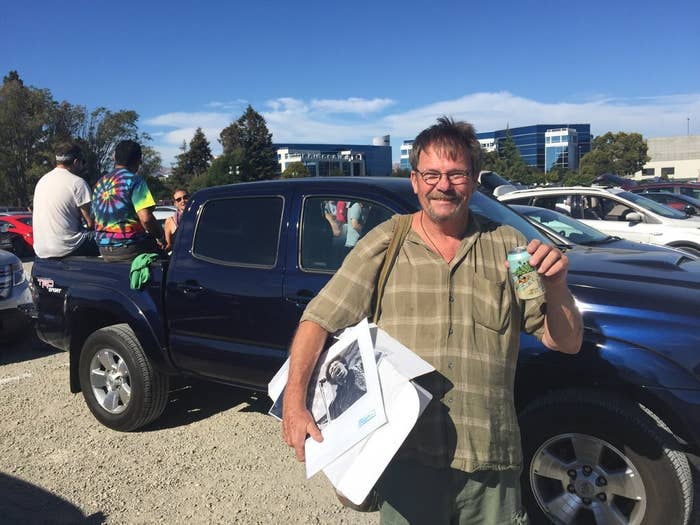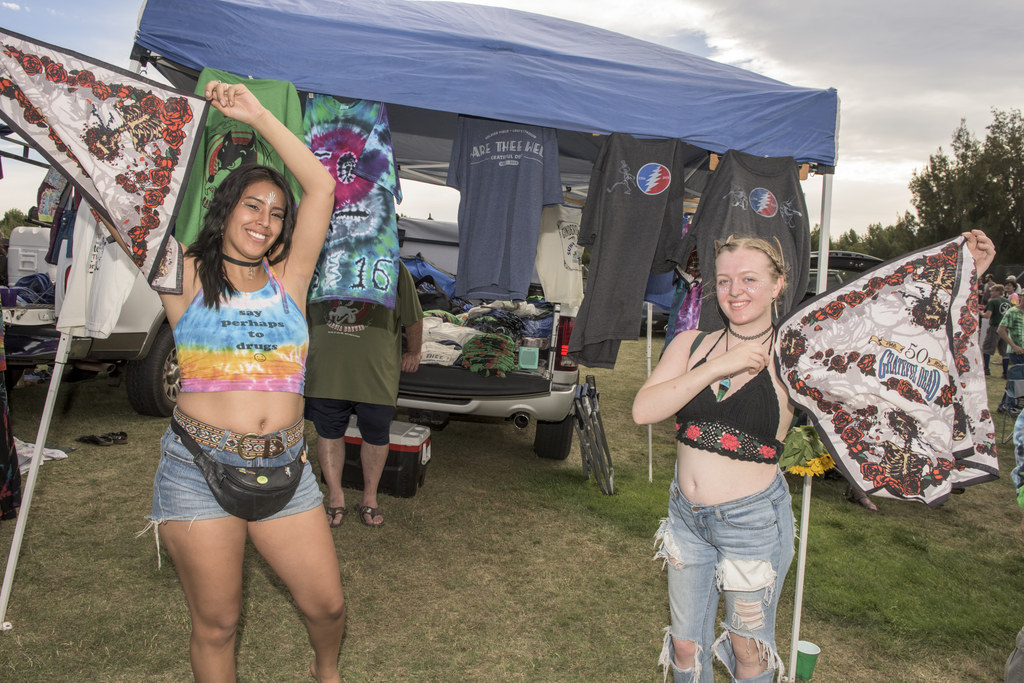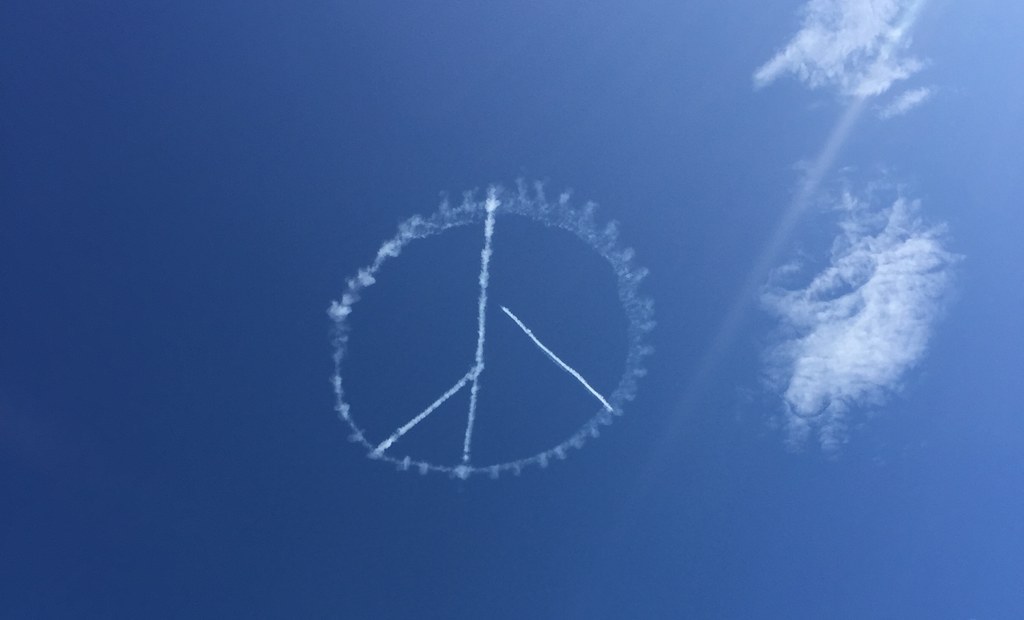
A miracle helped Ben get into the Grateful Dead show last Saturday. Other fans had panicked over ticket lotteries and complained publicly after being shut out of the band's five final "Fare Thee Well" concerts before they settle into retirement, but Ben came to Northern California's Levi's Stadium planning to do just what he's now spent decades doing in Dead show parking lots: selling whatever he could to pay for drugs, beer, and gas, and trusting that the universe would bring him a ticket.
The universe was listening. As showtime drew closer, suddenly lots of people in the lot seemed to have free extra tickets, and Ben got to see the surviving members of the band play for one of the last times. The following afternoon, in the hours leading up to the Sunday show, the grinning 60-year-old once again begin traversing a parking lot full of graying locs and more luxury SUVs than VW microbuses, introducing himself to new strangers every few minutes.
"When it's ganja treats, the line 'Just like mother used to make' cracks chicks up," Ben said. "They almost always buy when they hear me say that."
Ben found his tickets and was peddling band photos and homemade marijuana macaroons at the traveling, concert-adjacent circus slash freewheeling marketplace known as Shakedown Street, one of America's oldest and most storied places to buy drugs. Legend has it that the place now known as Shakedown Street existed as a nameless phenomenon before the band released a 1978 song and album called Shakedown Street. In the late '70s and early '80s, fans adopted the phrase to refer to the area in the parking lot where concertgoers and Deadheads could buy, sell, or trade not only mushrooms, pot, and LSD but also art, homemade food, beer, trinkets, tickets, and anything else a partygoer might want when the edges of the world are blurring and the noodling guitar solo in a 20-minute jam is wafting in from the show.
Between the late '70s and the mid-'90s, the thousands of concertgoers and thrill-seekers without tickets showing up to Shakedown Street could overwhelm local law enforcement in whatever town the band pulled into each week, so as to effectively suspend prohibition and allow an open drug trade. Shakedown Street has long served as the lovable sidekick to any Grateful Dead concert, a hub of good vibes, both real and chemically induced. In 2012, The New Yorker's Nick Paumgarten described the Shakedown Street at his first Dead show in 1984 as "the shabby human carnival that had taken over the parking lot and the pavilion: freaks dangling from trees, skulking muppets muttering, 'Acid, acid.'"
At the concerts this past weekend, even as the spirit of Shakedown Street infused smaller interactions throughout the parking lots, all that remained of a physical Shakedown Street was a small, humming bazaar between two rows of cars, no more than 50 yards long. "Where's Shakedown?" many of the old-timers wondered aloud, as they peered around the empty expanse in front of Levi's Stadium.

Still, lifelong Deadheads like Ben said that the scene felt just as vibrant and as when Shakedown Street first began.
"It was actually started by a guy named Sunshine selling stickers in front of [San Francisco's] Winterland [Ballroom, in 1974]," Ben recalled. "Everybody knew Sunshine — he's an awesome dude — and he was, like, the first official vendor guy. And then all of us started thinking, We have to go to the shows, we've got to sell some shit, so we did. I sold little things that you make out of rolling papers and spin on your fingers."
Ben also had fond memories of Roger Roach Clip's wire creations, made for holding the final centimeters of a burning joint, and some peacock feather earrings "that were really tremendous."
The person-to-person bartering of Shakedown Street's heyday, a nostalgic fantasy of pre-industrial capitalism and a forward-looking precursor to crowdfunding and microfinance, represents a form of commerce nothing like our current era of superstar-laden, corporate festivals.
There's something almost altruistic about the style of trade, perhaps because it's a little harder to screw over someone you're going to see at show after show. But if concert promoters want to maximize their profits, they need to control all of the buying and selling and bring it inside the concert. Coachella, Bonnaroo and the like mimic the look and feel of Shakedown Street, but H&M and Heineken set up air-conditioned tents and large scale public art comes pre-curated. Extra tickets sell for hundreds above face value on StubHub, and you'd be hard-pressed to find someone trading a ticket for a bag of Bugles, as Ben said he'd heard someone had done for a Dead ticket this past weekend.
Fare Thee Well's organizers briefly considered setting up a more modern version of Shakedown Street, with sponsored vendors, for some of the shows before realizing it was a terrible idea that would not sit well with a crowd that's historically not too keen on giving their cash to The Man.
"Nobody ever paid [for permits] except for the orange-juice guy. Fresh-squeezed orange juice," Ben said. "It was a good idea, but he would leave mounds of dead orange peels all over the parking lot."
At this past weekend's smaller, more low-key Shakedown Street, one man sat with an open suitcase and a handmade sign: "Smurf's Little Flea Market." Another held up a baggie full of dried mango in one hand and one full of live snails in the other. Several serene young people walked around passing out "I support psychedelic science" bumper stickers. The so-called "hip economy" of Shakedown Street lived on, but nearly a dozen Deadheads told BuzzFeed News the size and scope hardly compared to the enormous underground market they remembered. Other than in that single, short aisle, a concentrated area of card tables and face-to-face trade was nowhere to be found in and around Levi's Stadium.

Everyone had a theory for why Shakedown wasn't quite as big, for why time had passed, for why the universe wasn't the same as it ever was. With cannabis essentially legal to possess in California and many Deadheads becoming more bougie as they age, this past weekend's iteration of Shakedown Street felt both disappointing and unnecessary: A lot of people wanted to re-experience the magic of Shakedown Street, but only a few wanted to sell glass pipes, hustle snacks, or pick up psychedelics. Some fans halfheartedly wondered whether a bigger, wilder Shakedown Street might pop up and thrive at any of the three shows over the July 4 weekend, hoping for one last bacchanal at Soldier Field in Chicago before any possibility of future Grateful Dead concerts apparently comes to a real, final end.
Of course, the beginning of the end of the Grateful Dead happened long ago. Some say it started when the band experimented with disco, in the late '70s. Others say it was when the parking lot became a bigger scene than the concert itself, some time in the '80s. Most agree it really, finally happened when lead singer and hippie icon Jerry Garcia died in 1995, but some, like Ben, kept chasing the dream after that anyway, mixing with much younger crowds at Phish shows, or in the parking lot outside a Widespread Panic concert. It's hard to pinpoint, exactly, when a cultural phenomenon officially becomes out of touch or unrepresentative, but in 2015, it's clear the belief in a counterculture utopia, which motivated generations of fans to pick up their lives and follow the band from show to show to show for years on end, has been dying for quite some time.
But even though Ben was one of a dwindling number of devout Deadheads working the parking lot this past weekend, most people at the shows were getting high. They just didn't need to go to Shakedown Street to pick up their pot.

"Older people remember what it was like. It's amazing how lax it is now," one 44-year-old man told BuzzFeed News, talking about the drugs he used to sling at Dead shows back in the late '80s and early '90s. "I did 101 months, for eight felonies. We know what it was like before, with those old sentencing guidelines."
That guy now works in finance and coaches his kid's soccer team.
The police were certainly less concerned about drug use this past weekend than fans say they had been in the past. Instead, cops were on the lookout for unlicensed products featuring the logo or likeness of any member of the band. Ben carried his Dead photos beneath shots of Jimi Hendrix and Stevie Ray Vaughan. Nearby, a bunch of cops swarmed a guy selling off-brand merchandise while another man walked right by, calling out, "Mushrooms! Ecstasy! Doses!"
Doses of LSD, specifically, on small tabs of paper pulled from cross-body fabric purses. Ben approached a group of kids in torn, dark clothing selling crystals off the hood of a car.
"Jerry?" Ben asked, holding up his box of photos. A girl with locs sat in the front seat, eyes straight ahead, driving to nowhere.
"How much is that?" asked a guy with a wooden cane.
"20?"
"Trade?"
"For?"
"For mushrooms?" Ben asked, hopefully.
"LSD?" the guy responded. Ben nodded.
Ben handed the guy a photograph. Wrapping three dirty fingers around the top of his cane, the guy tore off a strip of red paper containing three tabs of acid, and then handed Ben an additional tab from somewhere else in the folds of his clothing.
Four doses. For one unlicensed photo of Jerry Garcia.
As he walked away, Ben explained that most of the acid at Grateful Dead shows, Phish shows, and the like still comes from people who look just like the guy with the cane and the dirt-caked skin.
"These kids are known as the Grateful Dead Family kids. GDF," he said. "They usually have a pile of dogs. Most people call them gutter punks." The GDF has been the main source of acid on Shakedown Street for decades, but their distribution network shrank several sizes in the past 20 years.
A$AP Rocky's recent paean to LSD aside, few rebellious teens in 2015 pine after jam bands or acid, having mostly moved on to electronic dance music, hip-hop, and whatever white crystals are passing for pure Molly these days. Some Deadheads even attribute the late-'90s shift in youth culture from tripping on acid to rolling on MDMA entirely to Jerry Garcia's death. Once the touring stopped, the GDF no longer had a roving market where they could sell their drugs, and the LSD followed them into the shadows.
Ben was less concerned with the rise of MDMA and more concerned with the tanks of nitrous oxide, or laughing gas, that began popping up around Shakedown Street 25 years ago.
Staring down the long line of people waiting for green balloons full of gas that would make them happy, Ben scowled.
"The dollars going into those guys' pocket never leaves their pocket. It disappears off the lot. They're paying $10, and there's a line," he said. "There's not a line in front of Jerry, here," he said, gesturing to his box of prints.
The police may have cared more about his unlicensed photographs than they did about the guys selling hits of laughing gas, but Ben cared more about the crime of exploiting his fellow concertgoers without putting something back into the community. As Ben walked from group to group, his Shakedown Street shtick was occasionally met with derision and the patronizing, officious tone of a suburban mom dismissing a panhandler.
Still, Ben soldiered on, chasing the hip economy, as it became clear that, oddly enough, the cops at the Grateful Dead show were the ones most in step with the times.
